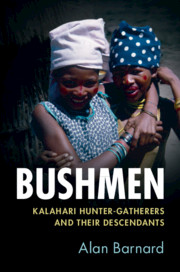Book contents
- Bushmen
- Bushmen
- Copyright page
- Contents
- Figures
- Tables
- Preface
- Pronunciation and Orthography
- 1 Bushmen
- 2 The Politics of Indigeneity
- 3 How Far Back Can We Go?
- 4 Discovery and Destruction of the /Xam
- 5 The !Xoõ and Their Neighbours
- 6 G/wi, G//ana and the Central Kalahari
- 7 Naro
- 8 Ju/’hoansi or !Kung
- 9 Hai//om
- 10 Bushmen of the Okavango
- 11 Sharing the Land with Others
- 12 Conclusions
- References
- Index
12 - Conclusions
Published online by Cambridge University Press: 11 July 2019
- Bushmen
- Bushmen
- Copyright page
- Contents
- Figures
- Tables
- Preface
- Pronunciation and Orthography
- 1 Bushmen
- 2 The Politics of Indigeneity
- 3 How Far Back Can We Go?
- 4 Discovery and Destruction of the /Xam
- 5 The !Xoõ and Their Neighbours
- 6 G/wi, G//ana and the Central Kalahari
- 7 Naro
- 8 Ju/’hoansi or !Kung
- 9 Hai//om
- 10 Bushmen of the Okavango
- 11 Sharing the Land with Others
- 12 Conclusions
- References
- Index
Summary
Finally, a conclusion draws everything together, largely on a theoretical level. Is there any such thing today as a hunter-gatherer? Can the positivist notion of ethnic groups as discreet entities ever be justified, especially in light of self-definition, multilingualism, long-term social change and intermarriage? Is a deep history implied in Bushman studies, for example in the retention of religious ideas from one end of southern Africa to the other? Are there theories that might help, such as ‘regional structural comparison’ (employed in some of my earlier work)? We know that the various groups are linked linguistically as a Sprachbund (a set of languages related through convergence, rather than through common descent). Might this have implications for the study of ethnicity? Language history? Indeed, are relations between southern Africa and other parts of the continent implicated too?
Keywords
- Type
- Chapter
- Information
- BushmenKalahari Hunter-Gatherers and Their Descendants, pp. 166 - 176Publisher: Cambridge University PressPrint publication year: 2019

